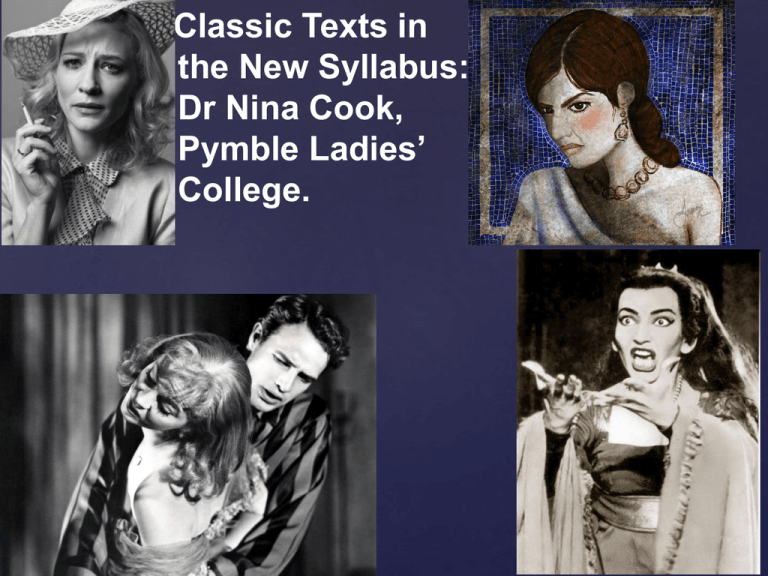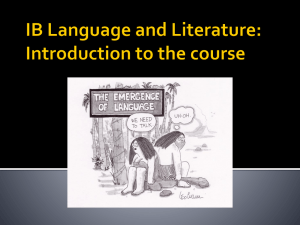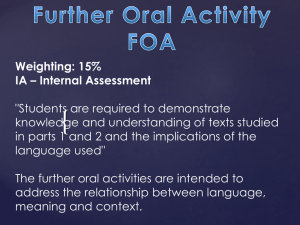Classic Texts in the New Syllabus Presentation
advertisement

Classic Texts in the New Syllabus: Dr Nina Cook, Pymble Ladies’ College. Our aim whilst implementing the new syllabus is to promote a culture of thinking within our school. Whilst planning for next year we see an opportunity to develop the work that our Director of Teaching and Learning is implementing and that is being furthered through relationships with schools such as Masada. I would like to: • explain a Teaching for Understanding model; • link this model to Stage 5 and NSW syllabus outcomes; • investigate how this model may promote critical and creative thinking; • discuss how two classic texts may lend themselves to this model; • provide some useful tools for promoting thinking within the classroom. What if education were less about acquiring skills and knowledge and more about cultivating the dispositions and habits of mind that students will need for a lifetime of learning, problem solving, and decision making? (Ron Ritchhart) What is Teaching for Understanding? “…teachers already strive to teach for understanding. So this performance view of teaching for understanding does not aim at radical, burn-thebridges innovation. Its banner is not “completely new and wholly different” but a just-as-crucial “more and better.” Perkins, David and Tina Blythe, “Putting Understanding Up Front” Teaching for Understanding provides teachers with a language and structure for planning their curriculum and for discussing teaching for understanding with other colleagues and with their students. It also stresses in depth learning. I am going to discuss the five elements of an understanding framework: • Generative Topics • Throughlines • Understanding Goals • Performances of Understanding • Ongoing Assessment 1. Generative Topics: Generative topics are the “big” ideas in the course that merit attention. Generative topics are issues, themes, concepts, and ideas that provide enough depth, significance, connections, and variety of perspectives to support students' development of powerful understandings. They should be: • Central to one or more disciplines; • Interesting to students and teachers; • Accessible to students; • Provide opportunities for multiple connections. How Medea and A Streetcar Named Desire led us to our Generative Topics: Edith Hall says of Medea, ‘The play must have been ethically shocking, Medea stands alone amongst tragic felons in committing her offence with impunity.’ This led us to see that both texts allow an exploration the question: what is justice? Both texts study the effect of being outside the mainstream of a society and how social understanding may be developed through empathy and tolerance. Tennessee Williams has said: ‘… people that have to fight for their reason; people for whom the impact of life and experience from day to day, night to night, is difficult; people who come close to cracking. That’s my world, those are my people.’ So these two texts allow students to investigate how the effect of social isolation and lack of understanding can lead to breakdown, suffering and violence. These ideas led us to focus upon: • What is justice? • What is the effect of being outside the mainstream of a society? • How does social isolation and lack of understanding lead to breakdown, suffering and violence? From this focus we are already considering some of the General Capabilities outlined in the new syllabus: • critical and creative thinking; • ethical understanding; • personal and social capability; • difference and diversity. 2. Throughlines: ‘Overarching goals, or throughlines, describe the most important understandings that students should develop during an entire course. The understanding goals for particular units should be closely related to one or more of the overarching understanding goals of the course.’ Throughlines: • What is the effect of being outside the mainstream of a society and how can social understanding be developed through empathy and tolerance? • How does the composer shape language features, structural devices and conventions of the medium and/or genre of the text to influence the responder’s response to the experiences and feelings of someone outside the mainstream? • How do texts encourage contemporary responders to re-evaluate aspects of their own society? • How do we comprehend what is fair and unfair in our world? • Is it possible for some texts retain value and integrity across the boundaries of time/place/culture? 3. Understanding Goals Understanding Goals, ‘identify the concepts, processes, and skills that we most want our students to understand. They are worded in two ways: as statements (in forms such as, "Students will understand ..." or "Students will appreciate ...") and as open-ended questions, what do I want my students to understand after having studied this unit? Question form: What is the impact of society upon the individual? Statement form: Social understanding may be developed through comprehending what it means to be an outsider. Question form: How do playwrights allow the audience to experience the feelings of individuals as they navigate the expectations of society? Statement form: Through tragedy playwrights can present the experience of the outsider in order to develop empathy and understanding. Question form: How does witnessing the characters struggles help develop our own sense of empathy and tolerance? Statement form: Witnessing the tragedy of others can help to develop social understanding and empathy for others. Question form: How can you use an aspect of the tragic form to demonstrate understanding of the characters plight? Statement form: Aspects of the tragic form can be employed by students to express the plight of the outsider. Linking Outcomes to the Understanding Goals: Outcome 1: A student responds to and composes increasingly sophisticated and sustained texts for understanding, interpretation, critical analysis, imaginative expression and pleasure. Outcome 5: A student thinks imaginatively, creatively and interpretively about information, ideas and texts when responding to and composing texts. Outcome 6: A student investigates the relationships the relationships between and among texts. Outcome 7; A student understands and evaluates the diverse ways texts can represent personal and public worlds. Outcome 8: A student questions, challenges and evaluates cultural assumptions in texts and their effects on meaning. 4. Performances of understanding: ‘Activities that both develop and demonstrate students’ perceptions of the understanding goals by requiring them to use what they know in new ways. The require the applying of knowledge and are visible.’ 5. Ongoing Assessment: Ongoing assessment is the process by which students get continual feedback about their performances of understanding in order to improve them. This might involve feedback from the teacher, from peers, or from students' self-evaluation. Sometimes the teacher may give criteria, sometimes engage students in developing the criteria. This will lead to a Culminating Performance. While there are many reasonable approaches to ongoing assessment, the constant factors are shared: • public criteria; • regular feedback; • frequent reflection throughout the learning process.










